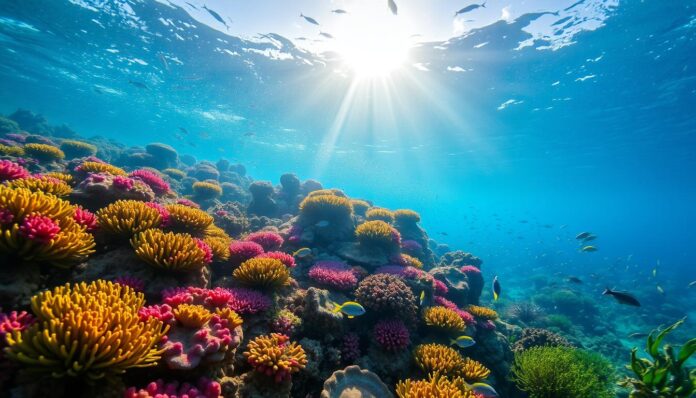| Best Time to Travel | March to May, September to November |
| What to Expect | Warm water, clear visibility, diverse marine life |
| Diving Conditions | Year-round, but best from March to May and September to November |
| Marine Life | Whale sharks, manta rays, turtles, sharks, dolphins, fish |
Are you ready to explore an underwater paradise? Malaysia’s dive sites offer some of the most breathtaking experiences on Earth. You’ll see vibrant marine ecosystems that change how you see underwater adventures.
Scuba diving in Malaysia is a world-class experience for all divers. You can dive in calm reefs or explore diverse marine environments. It’s a unique way to see the wonders of the sea, whether you’re new or experienced.
Malaysia’s location gives you many diving spots to choose from. You can dive all year in East Malaysia. Along the east coast, diving is best from March to September. This means you can plan your dives with excitement and flexibility.
Key Takeaways – Scuba Diving in Malaysia
- Malaysia offers diverse diving experiences for all skill levels
- Multiple dive destinations with unique marine ecosystems
- Year-round diving opportunities across different regions
- Affordable diving courses and packages available
- Protected marine parks with rich biodiversity
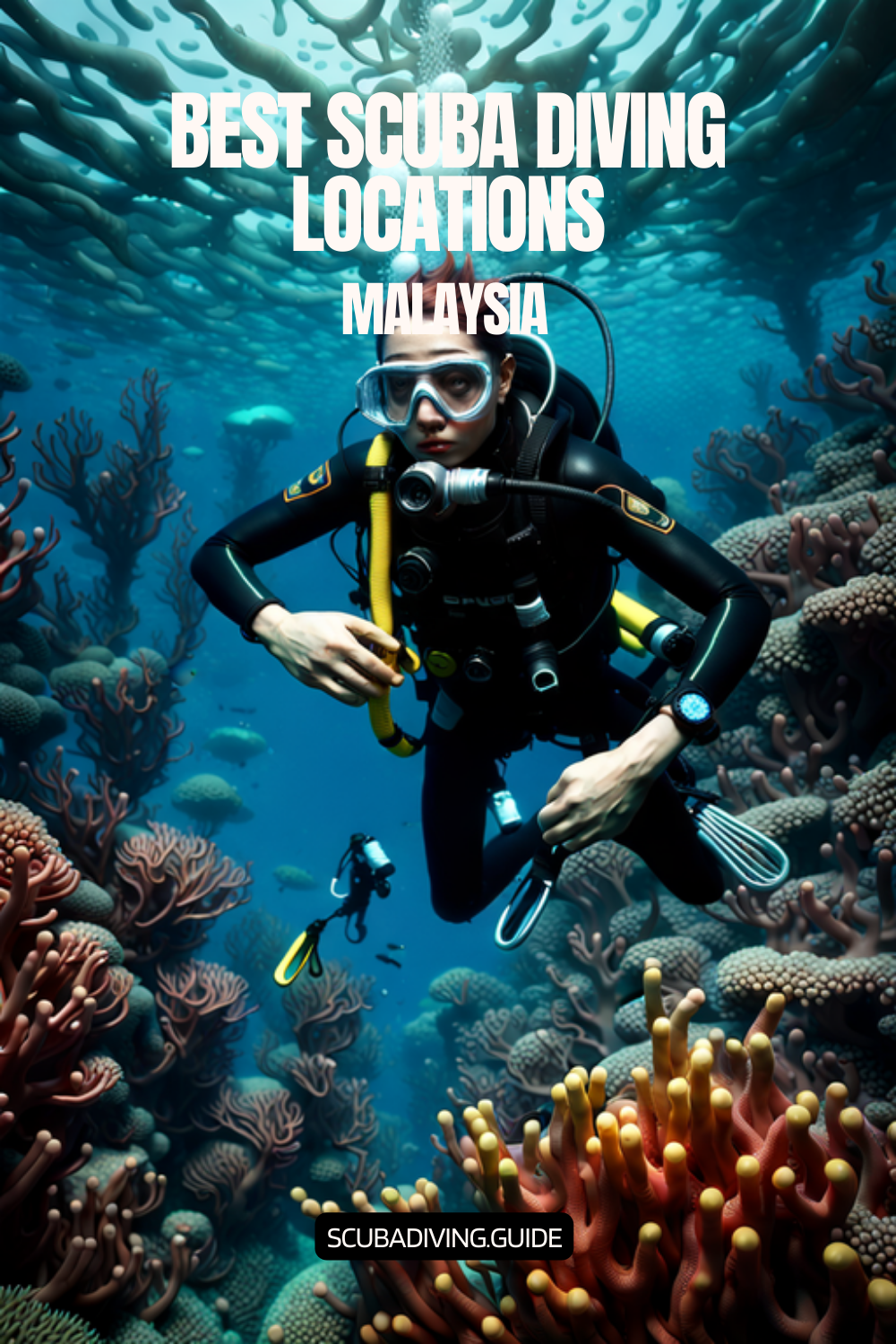
Introduction to Scuba Diving in Malaysia
Malaysia is a stunning underwater world for scuba diving fans. Its clear waters surround both Peninsular Malaysia and Malaysian Borneo. This makes it a top spot for diving, attracting explorers from everywhere.
Scuba Diving in Malaysia is a unique adventure. The country’s special location creates a rich diving scene. It’s full of marine life.
Overview of Malaysia’s Underwater Wonders
Malaysia’s seas are alive with color and life. It’s home to:
- Over 3,000 marine fish species
- Hundreds of diverse coral formations
- Unique diving environments ranging from coral walls to muck diving sites
“Malaysia’s underwater world is a hidden treasure waiting to be explored.” – Marine Conservation Expert
Why Malaysia is a Top Diving Destination
Photographers will love the underwater scenes in Malaysia. The country is known for:
| Diving Feature | Details |
|---|---|
| Water Temperature | 27-30°C (ideal diving conditions) |
| Visibility | 10-30 meters depending on location |
| Best Diving Season | April to October |
Places like Sipadan Island are famous for their marine life. The warm, clear waters are perfect for all divers. It’s a chance to see an amazing underwater world.
Popular Scuba Diving Spots in Malaysia
Malaysia is a paradise for scuba diving, with its stunning underwater world. You can explore everything from beautiful coral reefs to unique macro photography spots. Each dive site offers a unique experience for those who love the sea.
Sipadan Island: A Diver’s Paradise
Sipadan Island in Malaysia is a top spot for divers. It’s a marine sanctuary with incredible marine life. Here, you can see:
- Large schools of barracudas
- Numerous green and hawksbill turtles
- Spectacular coral wall formations
Perhentian Islands: Vibrant Coral Reefs
The Perhentian Islands are perfect for both new and seasoned divers. The waters are calm and full of life. You can dive into:
- Pristine coral gardens
- Diverse marine ecosystems
- Gentle currents perfect for novice divers
Mabul Island: Macro Photography Haven
Mabul Island is a dream for underwater photographers. It’s famous for its macro life. Here, you can find:
- Rare crustaceans
- Unique nudibranch species
- Exotic marine creatures like frogfish
Layang-Layang: Drift Diving Experience
Layang-Layang is great for drift diving with amazing marine encounters. You might see:
- Potential hammerhead shark sightings
- Strong ocean currents
- Expansive pelagic marine life
“Malaysia’s dive sites are not just locations, they are underwater universes waiting to be explored.” – Marine Exploration Magazine
| Dive Location | Key Features | Best Season |
|---|---|---|
| Sipadan Island | Turtle populations, wall diving | April-December |
| Perhentian Islands | Shallow reefs, beginner-friendly | March-October |
| Mabul Island | Macro photography, unique species | Year-round |
| Layang-Layang | Drift diving, pelagic encounters | March-May |
Unique Marine Life Encountered While Diving
Scuba diving in Malaysia opens a window to a vibrant underwater world. It’s full of amazing marine creatures. The country’s rich marine ecosystems offer divers a chance to see diverse and fascinating marine life. This is true for both Peninsula Malaysia and Malaysian Borneo.
Fascinating Coral Species
Malaysia’s coral reefs are treasures of the ocean. They cover a small part of the ocean but are home to many marine species. These underwater worlds are critical habitats for many marine organisms. They create colorful and complex landscapes that attract Underwater Photography Malaysia fans.
- Home to over 25% of marine species
- Located within the world-renowned Coral Triangle
- Featuring complex and diverse reef structures
Encountering Turtles and Sharks
Divers in Malaysia can have amazing encounters with big marine animals. The waters are home to many sea turtle species and different shark populations. These encounters make for unforgettable underwater experiences.
| Marine Species | Typical Sighting Locations | Best Viewing Months |
|---|---|---|
| Green Sea Turtles | East Coast Islands | Year-round |
| Whitetip Reef Sharks | Nationwide | Year-round |
| Whale Sharks | East Coast Peninsula | July-October |
Uncovering the World’s Smallest Fish
Malaysia’s marine environments are home to more than just big creatures. Macro photography lovers will find incredible small marine life. This includes pygmy seahorses and rare nudibranchs that test photographers’ skills and creativity.
“The smallest creatures often tell the most fascinating stories underwater.” – Marine Biologist
From tiny creatures to huge marine mammals, Malaysia’s underwater world is incredibly diverse. It continues to amaze divers and marine enthusiasts from all over the world.
Choosing the Right Scuba Diving Courses
Scuba diving in Malaysia offers a wide range of PADI Courses for all levels. Whether you’re new or experienced, Malaysia has programs to enhance your underwater journey.
Choosing the right course is key to gaining confidence and skills. Courses start with basic certifications and move to specialized training.
Open Water Certification Overview
The PADI Open Water Diver course is for beginners. It lets you dive up to 18 meters (60 feet). The course includes:
- Theoretical classroom sessions
- Pool training
- Open water practical experience
- Comprehensive safety instruction
Advanced Diving Courses Available
Once you’ve learned the basics, you can take advanced PADI Courses in Malaysia. These courses improve your skills and open up new diving experiences.
| Course Name | Minimum Age | Certification Level |
|---|---|---|
| Advanced Open Water | 15 years | Intermediate |
| Deep Diver Specialty | 15 years | Advanced |
| Underwater Navigator | 10 years | Specialty |
Specialty Courses: Night and Wreck Diving
Specialty courses like Night and Wreck Diving offer unique dives. They’re for those 12 years old and up with an Open Water certification.
“Specialty certifications are the pathway to becoming a Master Scuba Diver – the ‘Black Belt’ of underwater exploration.”
Diving courses in Malaysia cost between RM1000 – RM2000. They offer a mix of theory and practical diving. By picking the right course, you can explore Malaysia’s stunning underwater world safely.
Essential Scuba Diving Gear and Equipment
Getting ready for an amazing underwater adventure in Scuba Diving in Malaysia means picking the right gear. Whether you’re new or have lots of experience, the right equipment makes a big difference.
Choosing the right scuba diving gear is key for safety and fun. Most dive centers in Malaysia let you rent equipment. But knowing what you need helps you make better choices.
Must-Have Diving Equipment for Beginners
- Mask: Essential for clear underwater vision
- Fins: Crucial for efficient underwater movement
- Wetsuit: Provides thermal protection and safety
- Buoyancy Compensator Device (BCD): Helps control underwater positioning
For beginners, IST dive gear is a good choice. Their Hope jacket style BCD costs RM1,260. It comes in sizes XXS-XL, fitting new divers well.
Advanced Gear for Experienced Divers
| Equipment | Price (RM) | Features |
|---|---|---|
| Mercury BCD | 1,580 | 420D TPU coated Nylon shell |
| R-860 Diaphragm Regulator | 1,100 | Flagship regulator model |
| Dive Computer | Varies | Essential for tracking dive parameters |
Sustainable Gear Choices for Eco-Conscious Divers
Today’s divers care about the planet. Eco-friendly gear includes:
- Recycled neoprene wetsuits
- Environmentally conscious mask and fin materials
- Reef-safe equipment coatings
“Choosing sustainable diving gear helps protect the marine environments we love to explore.”
When planning your Scuba Diving in Malaysia trip, remember to keep your gear in good shape. Rinse it after each dive and store it right to make it last longer and work better.
The Best Time to Dive in Malaysia
Scuba diving in Malaysia is an amazing adventure all year round. Knowing the seasons helps divers plan the best marine explorations. This is true for all dive sites in Malaysia.
Seasonal Diving Patterns
The diving calendar in Malaysia offers unique chances in different areas. Divers find the best conditions at specific times. These times make for the best underwater experiences.
- East Coast diving: Best from March to September
- West Coast: Accessible year-round
- Peak diving seasons: July and August
East Coast Seasonal Considerations
The east coast of Peninsular Malaysia has great diving from March to September. Places like the Perhentian Islands are perfect for marine exploration during these months.
| Region | Best Diving Months | Water Temperature | Visibility |
|---|---|---|---|
| Perhentian Islands | March – September | 82-86°F (28-30°C) | 15-60 ft (5-18 m) |
| Redang Island | April – October | 82-86°F (28-30°C) | 30-60 ft (9-18 m) |
West Coast Diving Seasons
The west coast offers consistent diving opportunities all year. Places like Langkawi and Penang are great for divers of all levels.
“Malaysia’s diverse marine environments provide year-round diving adventures for underwater enthusiasts.”
Weather and Diving Conditions
Weather is key for diving. The water stays between 82-86°F, making it comfortable for exploring.
- Whale shark sightings: July – September
- Hammerhead shark encounters: April – May
- Average visibility: 15-30 meters
Scuba diving in Malaysia offers incredible underwater adventures all year. Planning well ensures a memorable dive experience.
Planning Your Diving Trip to Malaysia
Planning a scuba diving trip to Malaysia is key. The country has amazing dive sites that draw divers from everywhere. Knowing how to travel, where to stay, and what to do locally makes your trip unforgettable.
Flight Options and Travel Tips
Getting to Malaysia’s top dive sites needs smart flight planning. Key airports include:
- Kuala Lumpur International Airport (main international hub)
- Tawau Airport (nearest to Sipadan)
- Kota Kinabalu International Airport
Pro Tip: Book flights 4-5 months early in peak diving seasons (April to December) for the best deals.
Visa Requirements for International Travelers
Most visitors can enter Malaysia visa-free for 90 days. But, visa rules differ by country. You’ll need:
- A valid passport with at least six months’ validity
- Proof of return or onward travel
- Enough money for your stay
“Preparation is the key to an exceptional diving expedition in Malaysia.” – Experienced Dive Instructor
Best Accommodation Choices Near Dive Sites
Choosing the right place to stay makes your dive trip better. You can find everything from cheap hostels to fancy resorts near great dive spots:
- Semporna: Affordable places near Sipadan
- Perhentian Islands: Eco-lodges and beach resorts
- Tioman Island: Lodging for all budgets
For a 5-day diving trip, budget from USD 750 to USD 1,500. This depends on your travel style and dive packages.
Safety Tips for Scuba Diving in Malaysia
Scuba diving in Malaysia is an amazing adventure. But, safety comes first. Knowing the right safety steps is key to a fun and safe dive in Malaysia’s beautiful waters.
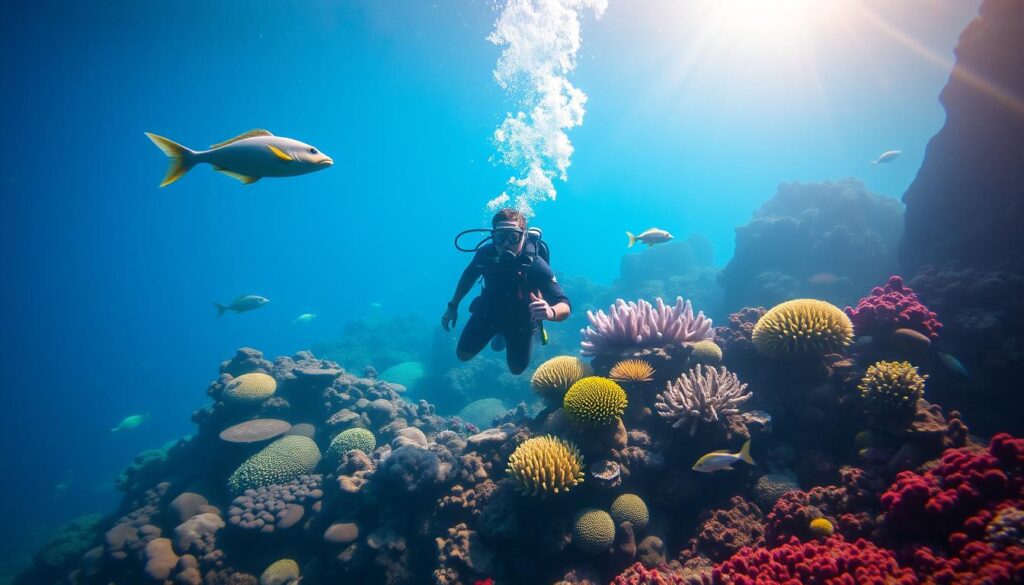
Before you dive, get ready and learn the basics. PADI Courses in Malaysia teach you how to stay safe and protect the sea.
Understanding Dive Signals and Communication
Good communication underwater is vital. You need to know important hand signals:
- Emergency signals for distress
- Basic directional communication
- Equipment and air supply indicators
- Marine life interaction warnings
Importance of Dive Insurance
Dive insurance is a must for safe diving in Malaysia. It covers you for unexpected issues. Here’s what it includes:
| Insurance Coverage | Protection Details |
|---|---|
| Medical Evacuation | Emergency transportation costs |
| Accident Treatment | Hyperbaric chamber expenses |
| Equipment Loss | Replacement of diving gear |
Environmental Responsibility While Diving
Responsible diving helps protect the sea. Here’s how to do it:
- Avoid touching coral reefs
- Maintain safe distances from marine life
- Use environmentally friendly sunscreen
- Follow local conservation guidelines
“Protect what you love. Every dive is an opportunity to be a marine conservation ambassador.” – Marine Ecology Expert
By sticking to these safety tips, you can enjoy Malaysia’s underwater wonders. You’ll also help keep the sea safe for future divers.
Health Considerations for Divers
Scuba diving in Malaysia needs careful health and safety focus. Tropical settings bring special challenges for divers. So, pre-dive health checks and good preparation are key for a safe dive.
Pre-Dive Health Screenings
Before starting PADI Courses Malaysia, divers must get full health checks. These include:
- Cardiovascular fitness assessment
- Respiratory system examination
- Ear and sinus health check
- Overall physical fitness evaluation
Managing Decompression Illness Risks
Decompression illness (DCI) is a big worry for divers. Here are some important facts:
| DCI Metric | Percentage |
|---|---|
| Occurrence in Recreational Divers | 0.01 – 0.019% |
| Patients with Neurological Manifestations | 61.5% |
| Full Recovery After Hyperbaric Oxygen Treatment | 76.0% |
“Swift medical intervention is critical for DCI treatment, specially within six hours of symptom onset.”
Hydration and Nutrition for Divers
Malaysia’s hot climate means divers must stay hydrated. They should:
- Drink 2-3 liters of water daily
- Avoid alcohol 12 hours before diving
- Eat foods rich in electrolytes
- Eat a balanced diet
Knowing these health tips makes scuba diving in Malaysia’s beautiful waters safer and more fun.
Photography Tips for Underwater Diving
Underwater Photography Malaysia is a unique place where art meets the sea. Scuba Diving in Malaysia lets you see amazing underwater scenes. These scenes show off the area’s rich marine life.
To capture marine life, you need special skills and tools. Professional underwater photographers know the right gear and techniques are key.
Essential Photography Gear for Divers
- Waterproof camera housing
- Wide-angle and macro lenses
- Underwater strobe lights
- Color correction filters
- Compact digital cameras with underwater modes
Techniques for Capturing Marine Life
Malaysia’s underwater world is full of photo opportunities. Places like Sipadan’s reefs and Borneo’s marine life are incredible for photos.
“Great underwater photography is about patience, technique, and understanding marine behavior.”
Key techniques include:
- Maintaining neutral buoyancy
- Using appropriate lighting
- Approaching marine creatures slowly
- Understanding subject behavior
- Practicing composition skills
Sharing Your Underwater Adventures
Today, photographers can share their underwater stories online. Sites like social media, photography websites, and conservation forums are great for showing off marine life.
Whether you’re new or experienced, Scuba Diving in Malaysia offers amazing photo opportunities. It’s a chance to tell stories with your photos underwater.
Eco-Tourism and Sustainable Diving Practices
Scuba diving in Malaysia is more than just fun. It’s about keeping the ocean’s beauty alive. Divers play a big role in saving these underwater worlds.
Keeping marine life safe needs everyone’s help. Here are some ways to do it:
- Maintain proper buoyancy control to avoid damaging coral reefs
- Use reef-safe sunscreen with mineral-based ingredients
- Never touch or disturb marine wildlife
- Participate in local conservation programs
Diving with Respect: Conservation Tips
Eco diving means less harm to the sea. Here’s how you can help:
- Follow strict rules in marine protected areas
- Support local conservation efforts
- Choose dive operators that care for the sea
Participating in Coral Restoration Programs
Malaysia is a great place for marine conservation. Groups like Reef Check Malaysia check over 300 coral reefs each year. They help protect our oceans.
“Every dive is a chance to protect our underwater world” – Marine Conservation Expert
Supporting Local Diving Communities
Choosing the right dive operators and joining local efforts helps a lot. For example, Lang Tengah Turtle Watch has saved over 150,000 turtle eggs.
Dive with care, protect our oceans, and keep Scuba Diving in Malaysia beautiful for all to enjoy.
Notable Dive Operators and Schools in Malaysia
Malaysia is a paradise for scuba diving lovers. It has many dive operators that offer unique experiences in its beautiful marine areas. You can dive in places like Sipadan and the Perhentian Islands. These are all part of the professional PADI Courses Malaysia.
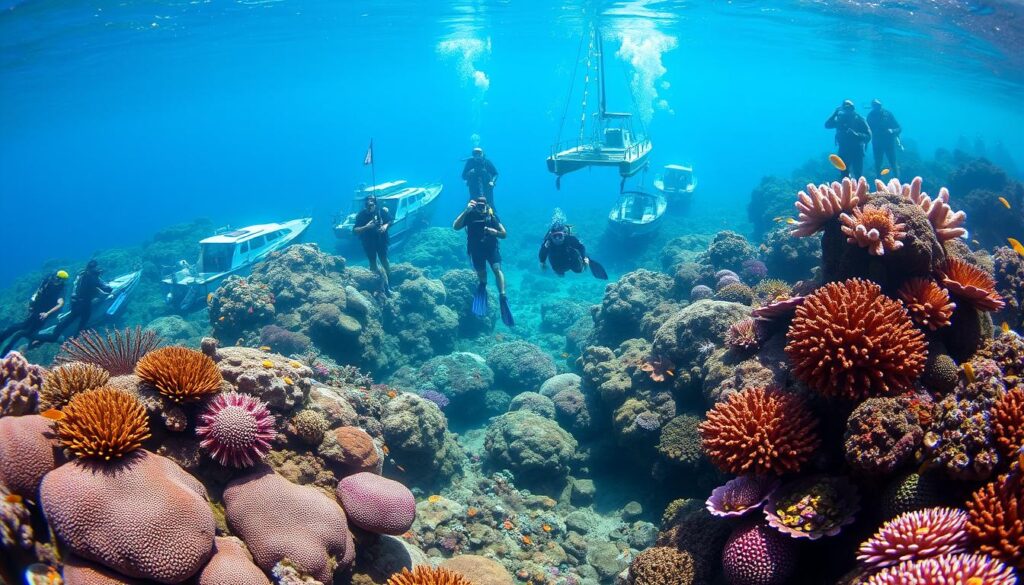
Choosing the right dive operator can make your dive unforgettable. They ensure your safety, guide you well, and give you amazing marine experiences.
Top-Rated Dive Centers in Sipadan
Sipadan is known for its amazing diving spots. There are only a few permits given out each day. Here are some top dive centers:
- Sipadan Scuba (First PADI 5 Star Instructor Development Center in Semporna)
- Scuba Junkie Mabul Beach Resort
- Borneo Divers
Recommended Schools in Perhentian Islands
The Perhentian Islands are great for learning to dive. Here are some recommended places:
- Asia Diving Vacation
- Perhentian Dive Center
- Turtle Bay Divers
Choosing a Reliable Dive Guide
When picking a dive operator, look for these things:
- PADI certification
- Safety record
- Equipment quality
- Environmental practices
| Dive Operator | Location | Specialization |
|---|---|---|
| Sipadan Scuba | Semporna | Advanced Certification |
| Scuba Junkie | Mabul | Conservation Efforts |
| Asia Dive Holidays | Peninsular Malaysia | Beginner Courses |
“Choosing the right dive operator can make the difference between a good dive and an extraordinary underwater experience.”
Pro tip: Always check the operator’s credentials and recent reviews before booking your dive.
FAQs about Scuba Diving in Malaysia
Starting your Scuba Diving in Malaysia adventure can raise many questions. Knowing the key details can make your underwater journey amazing. Our guide covers the most important diving aspects in this tropical paradise.
If you’re taking PADI Courses Malaysia, knowing the certification rules is vital. From September 2022, diving at top spots like Sipadan Island needs an Advanced Open Water certification. Make sure to finish your advanced training before you go, so you can dive at Malaysia’s best spots without hassle.
Common Questions for First-Time Divers
The Perhentian Islands in Malaysia are great for diving from April to October. Dives usually go down to 24 meters, with visibility of 7-15 meters. For those watching their budget, multi-day dive packages can cut costs from RM80 to about RM60 per dive.
Important Regulations and Guidelines
Following local maritime rules is key for a great dive. Know the area restrictions, marine conservation rules, and what gear you need. Also, check your travel insurance covers diving and carry your certification when exploring Malaysia’s underwater world.
Cultural Etiquette for Divers
Knowing local customs makes your dive better. Malaysian dive communities value respect and care for the environment. Listen to local dive masters, avoid harming the marine ecosystem, and show genuine interest in local cultures.
Malaysia Recommended Scuba Diving Itinerary
Planning a scuba diving trip in Malaysia can be an exciting endeavor, given the country’s abundance of remarkable dive sites. To help you make the most of your diving adventure, here is a recommended scuba diving itinerary that combines some of the best dive locations Malaysia has to offer:
Day 1: Arrival in Kota Kinabalu, Sabah
Upon arrival in Kota Kinabalu, the capital city of Sabah, take some time to settle into your accommodation and explore the vibrant city. In the evening, visit the local night markets to sample delicious Malaysian cuisine and soak in the lively atmosphere.
Day 2-3: Sipadan Island
Start your diving journey with a visit to Sipadan Island, one of the world’s most coveted dive destinations. Take a short flight or boat ride from Kota Kinabalu to Semporna, the gateway to Sipadan. Spend two days exploring the mesmerizing underwater world of Sipadan, with its stunning walls, diverse marine life, and chances to spot turtles, sharks, and schools of barracudas.
Day 4-5: Mabul Island
Continue your diving adventure by heading to Mabul Island, known for its exceptional muck diving opportunities. Dive into the world of macro photography as you search for flamboyant cuttlefish, mimic octopuses, and various nudibranch species. Mabul Island is also a popular spot for night dives, where you can witness the nocturnal creatures that come to life in the darkness.
Day 6-7: Layang-Layang Island
From Mabul, embark on a liveaboard or a short flight to Layang-Layang Island. This remote and pristine diving destination offers incredible encounters with large pelagic species, including hammerhead sharks, manta rays, and schools of barracudas. Explore the vibrant coral reefs and steep walls, and take in the breathtaking views of the surrounding turquoise waters.
Day 8-9: Redang Island
Next, make your way to Redang Island on Malaysia’s east coast. Dive into the crystal-clear waters and explore the vibrant coral formations that are home to an array of marine life. Enjoy drift dives along the walls and encounters with turtles, reef sharks, and schools of tropical fish. Above the water, take some time to relax on the beautiful beaches and indulge in the island’s tranquil ambiance.
Day 10-11: Tioman Island
Conclude your diving itinerary with a visit to Tioman Island, a true tropical paradise. Dive sites such as Tiger Reef, Renggis Island, and Soyak Island offer a range of underwater landscapes, including submerged pinnacles, colorful coral gardens, and fascinating walls. Encounter turtles, rays, and an abundance of marine biodiversity.
Day 12: Departure
After breakfast, bid farewell to the enchanting underwater world of Malaysia as you depart from Tioman Island. Reflect on the incredible diving experiences and cherish the memories made throughout your scuba diving journey in Malaysia.
Note: This itinerary can be customized based on your preferences, time constraints, and diving certifications. It is recommended to consult with local dive operators and consider factors such as weather conditions and dive site availability when planning your trip.
Embarking on this scuba diving itinerary will provide you with a diverse range of diving experiences, from encountering large pelagic species in Layang-Layang to exploring vibrant coral reefs in Redang and Tioman. Malaysia’s underwater wonders are sure to leave you with unforgettable memories and a deep appreciation for the country’s remarkable marine ecosystems.
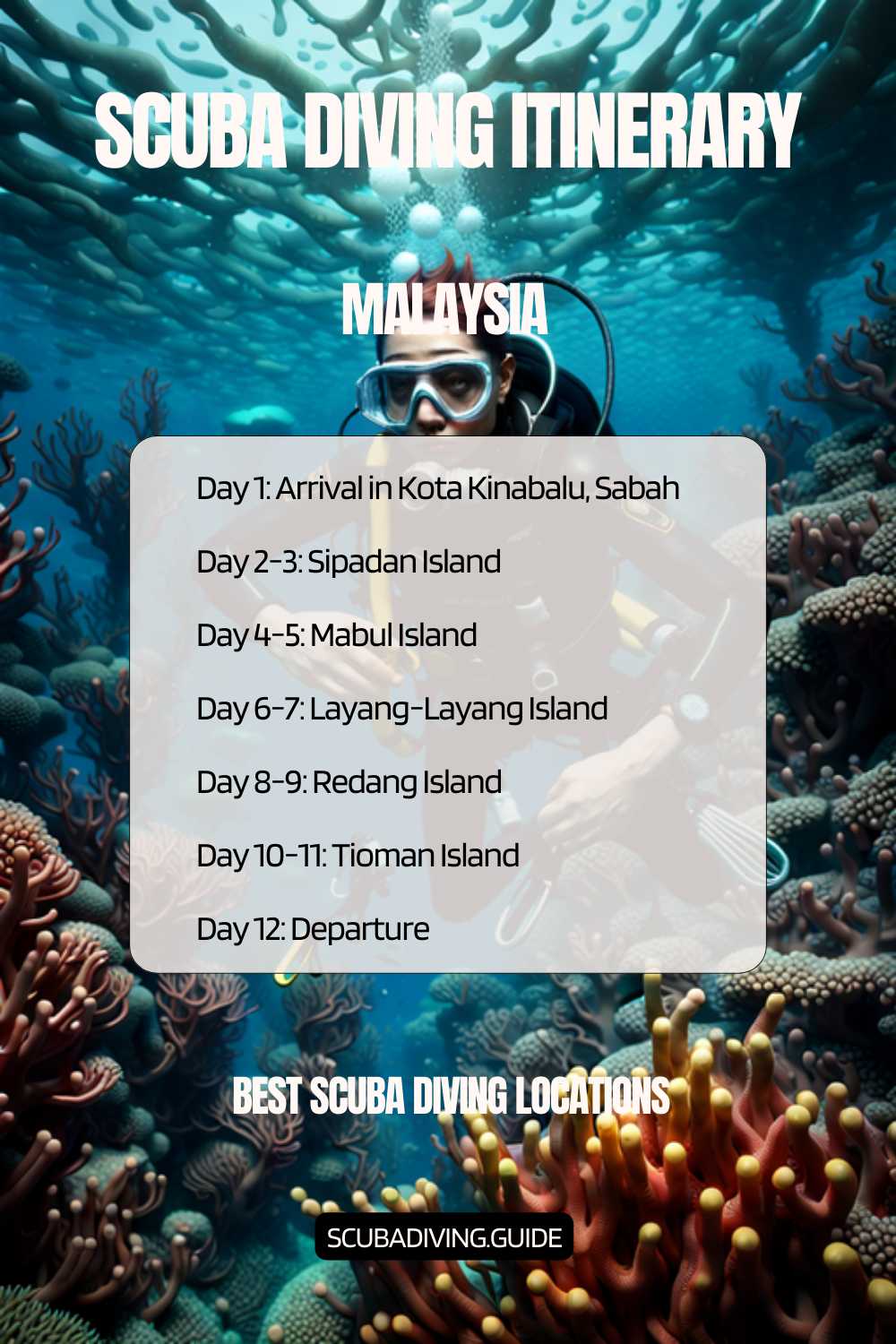
Other Countries to Consider
FAQ – Scuba Diving in Malaysia
Do I need prior diving experience to dive in Malaysia?
No, Malaysia welcomes divers of all levels. Beginners can start with PADI Open Water courses at many dive centers. The Perhentian Islands are great for new divers. Experienced instructors will help you get certified and feel at ease.
What is the best time of year to go scuba diving in Malaysia?
The diving season changes by location. The East Coast, like the Perhentian Islands, is best from March to October. The West Coast, including Langkawi and Penang, dives all year. Sipadan and Mabul are best from April to December, with the best months from June to September.
What marine life can I expect to see while diving in Malaysia?
Malaysia’s waters are full of life. At Sipadan Island, you’ll see barracuda, sea turtles, and reef sharks. Mabul Island is great for macro photography, with pygmy seahorses, nudibranchs, and more.
How much does scuba diving cost in Malaysia?
Prices vary by location and your certification level. A single dive costs $30 to $60. PADI Open Water courses are $350 to $450. These prices include equipment rental and are cheaper than many other places.
Is it safe to dive in Malaysia?
Yes, Malaysia is very safe for diving. Dive operators follow strict safety standards and many are PADI-certified. Always choose reputable centers, follow safety rules, and make sure you’re healthy enough to dive.
What diving certifications are recognized in Malaysia?
Malaysia accepts international certifications like PADI, SSI, NAUI, and BSAC. Dive centers offer courses for all levels, including specialties like deep diving and underwater photography.
Do I need special equipment for diving in Malaysia?
Most centers rent out equipment, but bring your own mask, snorkel, and wetsuit for comfort. The water is warm, so a thin wetsuit or rash guard is enough. Underwater cameras are great for capturing the marine life.
Are there any conservation efforts I can participate in while diving?
Many dive centers in Malaysia have marine conservation programs. You can help with coral restoration, underwater clean-ups, and monitoring marine life. Places like Sipadan have strict environmental rules, and divers are encouraged to dive responsibly.
What are the visa requirements for diving in Malaysia?
Most tourists can enter Malaysia visa-free for up to 90 days. But, visa rules vary by nationality. Always check the latest visa requirements and make sure your passport is valid for at least six months after your trip.
Can I take underwater photography courses in Malaysia?
Absolutely! Malaysia is perfect for underwater photography. Dive centers offer courses on photography techniques, camera handling, and composition. Mabul and Sipadan are top spots for photography.
